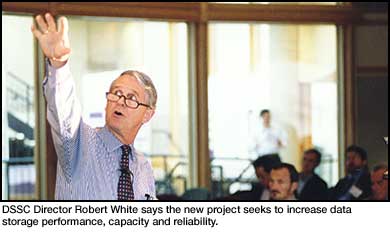|
|
||
|
|
|
 DSSC, Seagate Get $21.6 Million to Enhance Computer Data Storage
DSSC, Seagate Get $21.6 Million to Enhance Computer Data Storage
Carnegie Mellon's Data Storage Systems Center (DSSC) and Seagate Technology, along with other academic and industry partners, were awarded matching funds for a five-year, $21.6 million project to perform research in promising new data storage technology.
The award was granted by the Department of Commerce's Advanced Technology Program, administered by the National Institute of Standards and Technology.
Robert M. White, university professor of electrical and computer engineering and director of the 18-year-old DSSC, said the project seeks to develop dramatic increases in data storage performance, capacity and reliability.
The technology, known as Heat Assisted Magnetic Recording (HAMR), is expected to help the storage industry meet the challenge of keeping up with overall storage demands. The value of this new technology lies in the fact that the current technology is close to reaching its limit and HAMR promises to go beyond that limit by a factor of 100 or more, according to Carnegie Mellon researchers.
The need for increased storage has been pushed to the limit by continued expansion of computer networks, the proliferation of the Internet into every business function and home use, the extension into the entertainment industry and the emergence of new data storage consumer products.
"While disc drives can store a tremendous amount of information, our world now more than ever increasingly relies on the storage, exchange and communication of information," White said. "The result is that the need to deliver new advancements in storage technology, such as HAMR, has never been clearer."
HAMR will supplement modern magnetic disc drives that currently use magnetic heads to read and write digital data onto spinning platters. If the storage density continues its phenomenal growth rate within the next few years, the data bits will become so small that they may become thermally unstable due to a phenomenon known as superparamagnetism. The solution is to use a more stable medium, however, today's magnetic heads are unable to write data on such media.
HAMR solves this problem by heating the medium with a laser-generated beam at the precise spot where data bits are being recorded. When heated, the medium becomes easier to write, and the rapid subsequent cooling stabilizes the written data. The result of this heat-assisted recording is a dramatic increase in the recorded density that can be achieved.
"Although superparamagnetism is commonly thought of as a media problem, we have materials that could in principle store information at densities 100s of times higher than we have today, but we can't write on that material with conventional recording heads," said Seagate's Senior Vice President and Director of Research Mark Kryder.
"HAMR will make it possible to write the data reliably and thus circumvent the so-called superparamagnetic limit."
The DSSC, the country's leading center on magnetic recording, is an interdisciplinary research and education entity whose mission is to enhance the competitiveness of the data storage industry. The DSSC is supported by industrial sponsors and government agencies.
Seagate, the world's leading provider of data storage technology for the Internet, business and consumer applications, manufactures disc drives, magnetic discs and tape drives.
Seagate and the DSSC have a strong relationship that dates back nearly 20 years. The existence of Carnegie Mellon's DSSC was the major factor in the California-based company's decision to place its research facilities in Pittsburgh in 1998. Kryder was the founder and previous director of the DSSC.
Other research participants in the project include the Advanced Research Corp. of Minneapolis, Minn.; MEMS Optical Inc. of Huntsville, Ala.; the National Storage Industry Consortium of San Diego, Calif.; and the University of Arizona in Tucson.
Chriss Swaney
|
|
This Issue's Headlines || Carnegie Mellon News Home || Carnegie Mellon Home |
||